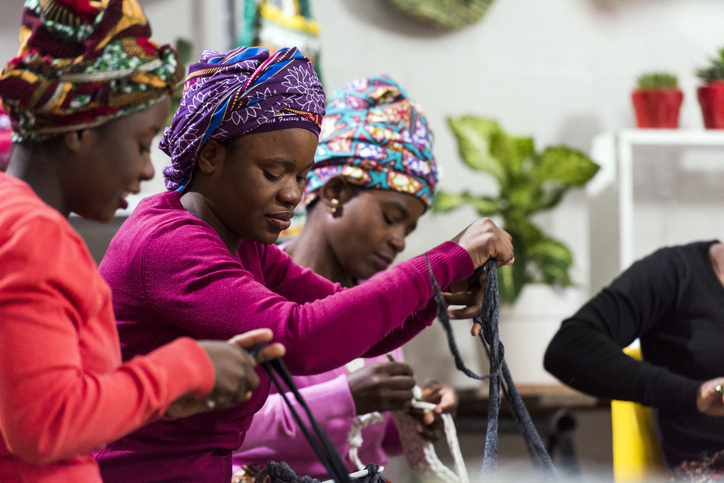Education is one of the most powerful instruments for laying the foundations for sustainable growth, reducing poverty and inequality, and improving the lives of women. But girls are less likely to go to school, more likely to drop out, and far less likely to go on to university. This column, which explores how to ensure access to high-quality secondary education for girls, concludes that making education work better for girls will improve results for boys too. When girls are learning, everybody wins.
Girls’ education is a driving force for economic development, geopolitical stability, and progress on climate change, as evidenced in research by the Foreign, Commonwealth and Development Office (FCDO) and the World Bank. Achieving better access and quality of girls’ secondary education in Uganda is a priority across the sector. But there is a disconnect between this aspiration and delivery: girls’ secondary education is not guaranteed and is a complex deliverable.
Secondary education is particularly challenging in terms of enrolment and access, especially among girls. Evidence shows that girls systematically fall behind in terms of school completion, educational attainment, and literacy levels. Less than 30% of adolescent girls complete lower secondary education in Uganda.
Furthermore, negative stereotypes hold girls back from education as cultural expectations of how girls are treated and raised, at home, at school, and in their communities, persist. This translates into how they are taught in the classroom, where evidence suggests that teachers traditionally have lower expectations and biases against female students.
Girls’ access to quality secondary education is linked to lower fertility rates and higher levels of female participation in society. Supporting girls to complete secondary education and achieve their full potential in educational attainment, and preparing them to be productive members of society requires gender-sensitive, participatory, and context-driven solutions.
Central to ensuring this delivery is consideration of the evidence around girls’ education and keeping it central to all program phases – planning, design, delivery, and monitoring. Several pieces of evidence show what works in practice.
Gender-responsive pedagogy
Global evidence highlights the important role of school leaders and teachers in improving educational outcomes for girls, by creating the right environment for learning. Building their capacity in instructional leadership for quality, equitable pedagogy is at the centre of this role.
But there are continued barriers to school leaders being able to fulfill this role. The Uganda National Strategy for Girls’ Education is an exciting step towards a cohesive approach to supporting girls in education and demonstrates the government’s commitment. Our experience shows that it can be challenging for school leaders to translate this into specific targets or outcomes, which can hamper implementation.
Training in specifically gender-responsive instructional leadership and school improvement planning is a critical driver for empowering teachers to support their female students. At secondary schools that are part of Promoting Equality in African Schools (PEAS), strong leadership is associated with an increase in test scores of up to 10 percentage points. It has also been shown that a key aspect of PEAS’ high quality school leadership is leaders’ understanding of individual student learning targets and that this strongly correlates with faster progress in learning.
When teachers are trained and supported to use learner-centered, gender-transformative teaching methods, there is consistent evidence of a change in the behaviors and attitudes of girls and boys in the classroom. Examples include asking girls and boys questions with the same level of difficulty, inviting girls and boys to participate in equal measure, and challenging widespread cultural bias about gendered roles and abilities.
This contrasts with the teacher-centered approach found historically in Ugandan schools. In the FCDO Girls’ Education Challenge evaluation at PEAS schools, 96% of girls who felt welcomed by their teachers envisioned completing school, whereas only 82% of girls who did not feel welcomed by their teachers at comparison schools envisioned completing secondary education.
Girls’ clubs
In addition to creating and delivering a gender-sensitive curriculum and pedagogy, enriching girls’ social and practical skills outside academia is important for their education and futures beyond formal schooling. These skills include building healthy relationships, dealing with stress and anxiety, and planning for the future. This is especially important after the negative impact of school closures: the increasing rate of teenage pregnancies as a result of Covid-19 is likely to intensify the gender gap for a whole generation, and demonstrates the crucial role of secondary education in reducing gender inequality (Mo Ibrahim Foundation).
One way in which soft skills can be successfully delivered is through girls’ clubs – dedicated spaces and groups in school that create a safe environment for all learners to explore their interests, learn about menstrual health and hygiene, and confide in teachers. There is robust evidence that clubs in a variety of settings can have positive impacts on girls’ life skills.
Girls’ clubs may also mitigate future negative impacts on enrolment and attendance caused by school closures, which is now more important than ever as high numbers of girls have been dropping out. This is particularly crucial in Uganda, where schools were closed for two years, the longest period anywhere in the world.
One mechanism identified in Sierra Leone reveals evidence that by providing girls with a club where they may continue to learn and maintain their social networks, they may be more able to avoid or delay pregnancy. While there is a place for targeted and well-planned interventions to tackle specific gendered barriers to education, evidence shows that interventions that deliver benefits for girls alone may lead to unintended consequences and increased divisions between girls and boys.
General interventions bring added value to boys and are just as effective at delivering high impact for girls as girl-focused interventions. This means embedding safeguarding, infrastructure, pedagogy, and life skills school-wide.
Girls’ clubs are also a central part of the PEAS model. The clubs are student-led to encourage more open discussion, as research has shown the effectiveness of this peer-to-peer model. Boys also participate in the clubs, to help change attitudes at the school and community level. In the evaluation carried out by the FCDO in 2019, teachers linked girls’ clubs to increased girls’ confidence.
Female role models drive girls’ attainment and successful post-school transitions
Evidence suggests that girls’ clubs and empowerment programs can help to shift gender norms, attitudes, and practices by increasing girls’ self-confidence, encouraging them to express their views. Exposure to female leaders as role models improves opinions of female students towards themselves and other girls and women, and weakens gender stereotypes about roles and norms. Research from Brookings also suggests that female role models meaningfully increase parents’ aspirations for their daughters and adolescent girls’ aspirations for their own education and careers.
Experience with role models also exposes learners to many useful life skills outside the classroom, and is an important strategy for the empowerment of adolescent girls that enables them to take control of their education. Skills development equips girls with the knowledge necessary to navigate adolescence, relationships, and the world of finance and savings.
Findings from the PEAS program highlight that girls are motivated to enroll and stay in school if they have female role models, and that this is reflected in the appointment of senior women teachers in PEAS schools. Evidence shows that engaging with the senior women teachers in PEAS schools leads to a 264% increase in girls’ chances of developing reading and writing skills.
Conclusion
In this article, we have explored some of the key components in providing access to education for girls. Prioritizing girls’ education and embedding systems such as the ones explored above into business as usual are crucial for long-lasting change. Making education work better for girls improves results for boys too. When girls are learning, everybody wins.





